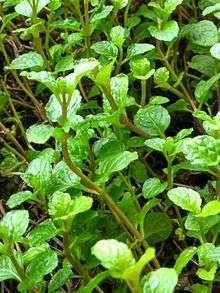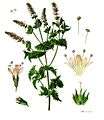Spearmint
| Spearmint | |
|---|---|
 | |
| Scientific classification | |
| Kingdom: | Plantae |
| Clade: | Angiosperms |
| Clade: | Eudicots |
| Clade: | Asterids |
| Order: | Lamiales |
| Family: | Lamiaceae |
| Genus: | Mentha |
| Species: | M. spicata |
| Binomial name | |
| Mentha spicata | |
| Synonyms | |
|
Mentha viridis | |
Spearmint (binomial Mentha spicata, synonym Mentha viridis), also known as garden mint, common mint, lamb mint and mackerel mint,[2][3] is a species of mint native to much of Europe and Asia (Middle East, Himalayas, China etc.), and naturalized in parts of northern and western Africa, North America, and South America, as well as various oceanic islands.[4][5][6][7]
- Subspecies[4]
- Mentha spicata subsp. condensata (Briq.) Greuter & Burdet—Mediterranean region; naturalized in New Zealand
- Mentha spicata subsp. spicata—most of species range
Description

Spearmint is a herbaceous, rhizomatous, perennial plant growing 30–100 cm tall, with variably hairless to hairy stems and foliage, and a wide-spreading fleshy underground rhizome. The leaves are 5–9 cm long and 1.5–3 cm broad, with a serrated margin. The stem is square-shaped, a trademark of the mint family of herbs. Spearmint produces flowers in slender spikes, each flower pink or white, 2.5–3 mm long, and broad.[5][8]
Hybrids involving spearmint include Mentha × piperita (peppermint; hybrid with Mentha aquatica), Mentha × gracilis (ginger mint, syn. M. cardiaca; hybrid with Mentha arvensis), and Mentha × villosa (large apple mint, hybrid with Mentha suaveolens).
The name 'spear' mint derives from the pointed leaf tips.[9]
History
John Gerard's Herbal (1597) states that: "It is good against watering eyes and all manner of break outs on the head and sores. It is applied with salt to the biting of mad dogs," and that "They lay it on the stinging of wasps and bees with good success." He also mentions that "the smell rejoice the heart of man", for which cause they used to strew it in chambers and places of recreation, pleasure and repose, where feasts and banquets are made."[10]
Cultivation
Spearmint grows well in nearly all temperate climates. Gardeners often grow it in pots or planters due to its invasive, spreading rhizomes. The plant prefers partial shade, but can flourish in full sun to mostly shade. Spearmint is best suited to loamy soils with abundant organic material.
Spearmint leaves can be used fresh, dried, or frozen. They can also be preserved in salt, sugar, sugar syrup, alcohol, or oil. The leaves lose their aromatic appeal after the plant flowers. It can be dried by cutting just before, or right (at peak) as the flowers open, about one-half to three-quarters the way down the stalk (leaving smaller shoots room to grow). Some dispute exists as to what drying method works best; some prefer different materials (such as plastic or cloth) and different lighting conditions (such as darkness or sunlight).
Oil uses
Spearmint is used for its aromatic oil, referred to as oil of spearmint. The most abundant compound in spearmint oil is R-(–)-carvone, which gives spearmint its distinctive smell. Spearmint oil also contains significant amounts of limonene, dihydrocarvone, and 1,8-cineol.[11] Unlike oil of peppermint, oil of spearmint contains minimal amounts of menthol and menthone. It is used as a flavoring for toothpaste and confectionery, and is sometimes added to shampoos and soaps.
Used as a fumigant, spearmint essential oil is an effective insecticide against adult moths.[12]
Beverages
Spearmint leaves are infused in water to make spearmint tea. Spearmint is an ingredient of Maghrebi mint tea. Grown in the mountainous regions of Morocco, this variety of mint possesses a clear, pungent, but mild aroma.[13] Spearmint is an ingredient in several mixed drinks, such as the mojito and mint julep. Sweet tea, iced and flavored with spearmint, is a summer tradition in the Southern United States.
Gallery
 Plant in flower
Plant in flower- Flowers
 1887 illustration
1887 illustration- Grown in Malaysia
References
- ↑ "Mentha L." Germplasm Resources Information Network. United States Department of Agriculture. 2004-09-10. Archived from the original on 2009-05-06. Retrieved 2010-01-30.
- ↑ Seidemann, Johannes (2005). World Spice Plants: Economic Usage, Botany, Taxonomy. New York: Springer. p. 229. ISBN 978-3-540-22279-8.
- ↑ "Mentha spicata, spearmint". RHS Gardening. Royal Horticultural Society.
- 1 2 "World Checklist of Selected Plant Families: Royal Botanic Gardens, Kew". kew.org.
- 1 2 "Flora of China Vol. 17 Page 238 留兰香 liu lan xiang ''Mentha spicata'' Linnaeus, Sp. Pl. 2: 576. 1753". Efloras.org. Retrieved 2018-08-16.
- ↑ Altervista Flora Italiana, Menta romana, Mentha spicata L. includes photos + distribution maps for Europe + North America
- ↑ "Biota of North America Program, 2013 county distribution map". Retrieved 2018-08-16.
- ↑ Huxley, A., ed. (1992). New RHS Dictionary of Gardening. Macmillan ISBN 0-333-47494-5.
- ↑ Turner, W. (1568). Herbal. Cited in the Oxford English Dictionary.
- ↑ Grieve, Maud (1971). A Modern Herbal: The Medicinal, Culinary, Cosmetic and Economic Properties, Cultivation and Folk-lore of Herbs, Grasses, Fungi, Shrubs, & Trees with All Their Modern Scientific Uses, Volume 2.
- ↑ Hussain, Abdullah I; Anwar, Farooq; Nigam, Poonam S; Ashraf, Muhammad; Gilani, Anwarul H (2010). "Seasonal variation in content, chemical composition and antimicrobial and cytotoxic activities of essential oils from four Mentha species". Journal of the Science of Food and Agriculture. 90 (11): 1827–36. doi:10.1002/jsfa.4021. PMID 20602517.
- ↑ Eliopoulos PA, Hassiotis CN, Andreadis SS, Porichi AE (2015). "Fumigant toxicity of essential oils from basil and spearmint against two major Pyralid pests of stored products". J Econ Entomol. 108 (2): 805–10. doi:10.1093/jee/tov029. PMID 26470193.
- ↑ Richardson, Lisa Boalt (2014). Modern Tea: A Fresh Look at an Ancient Beverage. San Francisco: Chronicle Books. p. 104. ISBN 978-1-4521-3021-7.
External links

